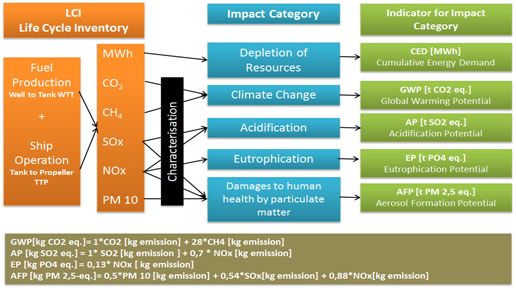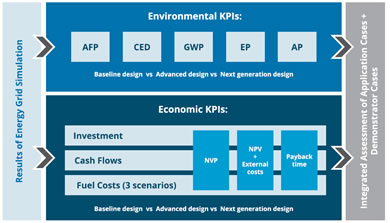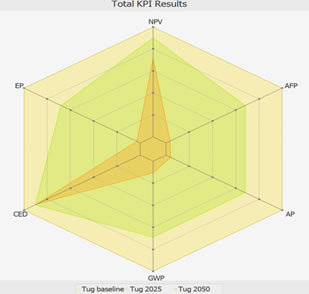Energy Grid Simulation
The Energy Grid Simulation in principle had to cover two different modelling strategies depending on the operation profile and technology used in the application cases:
- Quasi-stationary (constant loads, complex grid as for e.g. passenger ships or offshore patrol vessel)
- Dynamic (highly dynamic loads, main focus in defining of propulsion and energy converting components as for e.g. urban ferry, tug or dredger)
The modelling of the energy grid took place using different software tools as available at the leaders of the application cases resp. demonstrator cases like
- MATLAB Simulink
- Dymola
- Simulation X
- APROS
- EXCEL
- COSSMOS
In order to be able to provide simulation component models in a way that they can be used by all application cases, some standards for modelling had to be defined in advance before creating the simulation component models. A clear description of I/O had been intensively discussed and documented in the so called I/O matrix. A second challenge has been to define an exchange standard, which also allows for providing first principle models reflecting IP-restrictions. Finally, the FMI-standard has been tested in the first phase of the project and the final decision was made to use FMI version 1.0 in the course of the project.
Screening LCA
In order to be able to judge the overall environmental impacts from a product like e. g. a complete ship, the Life Cycle Assessment (LCA) acc. to ISO 14040 is the well adapted methodology. However, to perform such an LCA for ships, too much information is simply missing or not mature enough in an early design stage. All key decisions regarding operating profile, fuels, primary energy converters and other technologies affecting the overall energy efficiency of ships are taken before contract signing. To overcome this issue, the concept of a Screening LCA-Methodology for implementation in the JOULES project has been chosen. It means that only a very few selected environmental impact categories will be considered in order to identify the "hot spots". These impact categories (or KPIs in the context of JOULES project) have been carefully selected as shown the in figure below.
 KPIs for Environmental Assessment
KPIs for Environmental Assessment
The indicators (in this case mid-point indicators) fully reflect the societal and regulatory deliberations as outlines in chapter 2. The contribution of each of the emissions as gathered in the Life Cycle Inventory (LCI) to the impact categories are represented by so called characterisation factors. These characterisation factors have been chosen in the context of the JOULES project to reflect the regional or global impact of these emissions rather than very local effects like e. g. damages to health by particulate matter in highly populated areas close to busy ports. In order to reflect such impacts, end point indicators would be necessary but this scope could not be covered within the JOULES project.
The Global Warming Potential is the KPI addressing climate change and combines the impact of different greenhouse gases like CO2 and CH4[1]. Thus GHG-emissions (as from ships) always imply the total impact of these individual emissions on climate change as represented by the GWP. Consequently, the GWP is further applied in this deliverable in the context of the LCP-Assessment. The values as calculated in the assessment reflect the 100 years horizon as commonly used for long term strategic decision making in regard of climate change action.
The Cumulative Energy Demand (CED) reflects the depletion of natural resources like fossil fuels but also considers the future demand of renewable energy in the transition process towards ultra-low emission shipping. Therefore, this indicator is of outmost importance when comparing future pathways to produce GHG-neutral fuels from e. g. renewable electrical energy.
Reference for details of characterisation factors is given as follows:
CED: VDI-Richtlinie4600 (VDI 2012)
GWP: IPCC Fith
Assesment Report.(IPCC 2013, p. 714)[2]
EP / AP:
Handbook on life cycle assessment. (Heijungs et. al 2002)
AFP:
A set of emission indicators for long-range transboundary air
pollution (de Leeuw 2002)
[1] Also dinitrogen monoxide N2O is a main
contributor to climate change but not relevant in the context of the
JOULES project.
[2] Considering the footnote in
table 8.7, 30 would have been correct for CH4, however the
impact on total results would be marginal.
Financial Assessment
The NPV is very often used as KPI as Financial Assessment Methodology for economic decision making. It is well established in those cases where a comparison of alternative concepts is needed at equal life time. This is also the basis for comparison of the different design concepts in JOULES.
The most relevant issues when calculating the NPV of the different concepts are:
- Same Life Time of the concepts set to 25 years
- Judgement of the investment costs for each of the concepts
- Estimation of future cash inflows and outflows
- Specific fuel price predictions for all kinds of fuels as used in the project with particular high and low scenarios for fossil fuels
- Discount rate, which has been chosen to be 10 % reflecting an intended relatively short pay-back and reflecting also a higher risk margin
Using the NPV methodology, also pay-back times for investments (also referred to as Return of Investment (ROI)) can be identified and specific KPIs using ship type specific performance parameters complement the range of options for assessment.
In addition, the societal impact from the release of emissions from ships can be accounted for using state of the art scientific results from previous EU-funded projects like ExterneE, CAFÉ; or NEEDS. At to-days practice, the costs of damages to e.g. humans, buildings or biodiversity caused by harmful pollutants like SOx, NOx and particulate matter as well as costs for repairing damages from GHG-emissions are covered to a large extent by the society. The magnitude of these costs can be rather high. The LCPA- methodology as developed in JOULES allows in considering the impact of these external costs on a case by case basis.
Integrated Environmental and Economic Assessment
The methodology for the LCP-Assessment as developed in JOULES is shown below.
 Integrated Assessment Methodology in JOULES
Integrated Assessment Methodology in JOULES
The main objective is to compare for each application case the advanced design (2025) and next generation design (2050) against a reference vessel (state of the art) in terms of ecological impact and economic viability. The methodology as outlines above suits this purpose and provides results in different levels. The uppermost level is a spider graph, where the aim is to minimize the area of the hexagon established by the achieved KPI values for each design alternative:
 KPIs results for combined environmental and economic assessment
KPIs results for combined environmental and economic assessment
The spider graph in this example perfectly shows that all KPIs could have been improved over time incl. NPV. However, this is a result from various assumptions made in anticipating dedicated future developments for several input variables like fuel costs, discount rate, investment costs, maintenance costs, exchange rates etc. In other application cases, the spider graph might look different.


